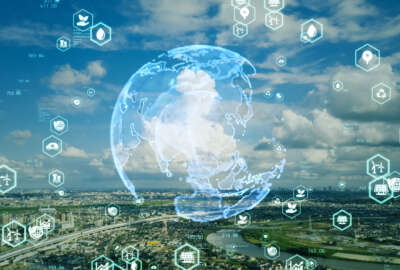

The Biden administration is instructing agencies on how to build up the federal workforce to meet its green-government goals.
The Biden administration is instructing agencies on how to build up the federal workforce to meet its green-government goals.
The White House Council on Environmental Quality released guidance this week directing agencies and the federal government as a whole to “develop new resources, trainings and systems to equip and inspire the federal workforce.”
“Agencies must develop, conduct, support and promote training, education and engagement activities that equip their workforce with the skills and tools necessary to achieve the sustainability objectives of the EO,” CEQ wrote in its guidance.
The guidance also outlines steps agencies must take to align with the administration’s ultimate goal of reaching net-zero emissions across all federal operations by 2050.
Along the way to meeting this goal, the administration expects agencies to source 100% carbon pollution-free electricity on a net annual basis by 2030, purchase only zero-emission vehicles by 2035 and achieve net-zero emissions across all federal buildings by 2045.
CEQ said the agency actions mandated in its guidance will set the foundation “for a decade of action to cut [greenhouse gas] emissions from federal operations and drive greater sustainability governmentwide.”
“Achieving these ambitious commitments requires action by each and every agency, starting today,” CEQ wrote.
CEQ states it will decide on metrics to track the development of a climate and sustainability-focused workforce no later than fiscal 2023, in partnership with the Office of Management and Budget and the Office of Personnel Management.
OPM, meanwhile, is working on a report analyzing the federal workforce’s role in climate adaptation and sustainability. The forthcoming report will specifically look at the state of agency engagement, employee training and leadership capabilities needed to achieve the administration’s green-government goals.
The guidance directs all agencies to develop human capital planning strategies to meet the goals of the executive order, and to provide metrics for meeting these goals.
That includes incorporating sustainability and climate action goals into employee performance plans, as well as identifying the “staffing, training and associated resources necessary to implement and achieve the goals” of the executive order.
The administration requires all new large federal construction and building modernization projects under design in fiscal 2022 or later to reach net-zero emissions by 2030, “and where feasible,” to become net-zero water and waste buildings.
“The goal is to increase efficiency, optimize performance, reduce emissions, encourage responsible use of materials and resources, ensure the health of occupants, reduce waste, and increase agency resiliency and adaptation to climate risks,” the guidance states.
This requirement applies to federal buildings and modernization projects that encompass more than 25,000 gross square feet. Agencies are expected to track progress toward this goal annually.
New federal buildings under construction must also meet or exceed the government’s sustainable design and operations principles.
“Energy efficiency, electrification, on-site renewable energy, and on-site energy storage can support agency efforts to achieve both sustainable federal building requirements and net-zero emissions goals,” the guidance states.
CEQ directs agencies to use sustainable building materials for the construction and modernization of federal buildings, and to include the necessary charging infrastructure to support a fully electric federal vehicle fleet.
The guidance also outlines considerations agencies must take when planning new facilities. These include ensuring federal facilities integrate with the existing local infrastructure, and ensure broad access to public transportation.
“It is the policy of the federal government to promote sustainable locations for federal workplaces and strengthen the vitality and livability of the communities in which they are located,” the guidance states.
The administration is also directing agencies to optimize their leased real estate and to consolidate their office space when possible, in order to “avoid unnecessary real property expenditures and reduce emissions, energy and water usage, and waste.”
The guidance will also help set into motion agency spending under the recently passed Inflation Reduction Act.
The $740 billion legislation tees up multi-year hiring and training investments at several agencies, including the Interior Department and its National Park Service, the Energy Department, the Environmental Protection Agency, the National Oceanic and Atmospheric Administration and CEQ.
The legislation gives the Postal Service $3 billion to purchase electric vehicles and install the charging infrastructure to support them at USPS-owned or leased facilities.
The General Services Administration gets $975 million to support emerging sustainable technologies, and an additional $250 million to convert federal facilities to “high-performance green buildings.”
GSA also receives $2.15 billion for low-carbon materials in the construction and upgrade of federal buildings, especially those that “have substantially lower levels of embodied greenhouse gas emissions” compared to industry standard materials, as determined by the EPA.
The Federal Permitting Improvement Steering Council, which already serves as a coordinating body for projects under the $1 trillion Bipartisan Infrastructure Law, gets $350 million for environmental review improvement.
Copyright © 2025 Federal News Network. All rights reserved. This website is not intended for users located within the European Economic Area.
Jory Heckman is a reporter at Federal News Network covering U.S. Postal Service, IRS, big data and technology issues.
Follow @jheckmanWFED



